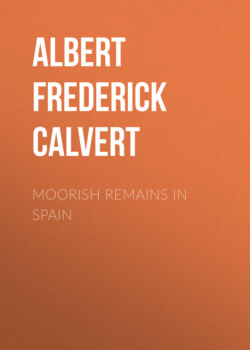Moorish Remains in Spain

Реклама. ООО «ЛитРес», ИНН: 7719571260.
Оглавление
Albert Frederick Calvert. Moorish Remains in Spain
Moorish Remains in Spain
Table of Contents
PREFACE
LIST OF COLOURED PLATES
MOORISH REMAINS IN SPAIN
INTRODUCTORY
CORDOVA
SEVILLE
TOLEDO
MOORISH ORNAMENT. A NOTE ON THE ELEMENTS OF ARAB ART
DESCRIPTION OF THE PLATES
Отрывок из книги
Albert Frederick Calvert
Published by Good Press, 2022
.....
Table of Contents
OF the four great cities of the Mohammedan domination in Spain, Cordova, as the seat of the Khalifate established by Abd-er-Rahman I., is rightly regarded as chief. The sun of the Moslem era shone with dazzling brilliance on Seville, and pierced the shadows of grim Toledo ere it set upon the decaying grandeur of Granada; but it had risen first on Cordova, and from “that abode of magnificence, superiority, and elegance” its glory had been reflected to the furthest corner of the civilised world. For Cordova, by reason of its climate, its situation, and its surroundings has, since the beginning of time, been one of the garden spots of Europe. The Carthaginians had aptly styled it “the Gem of the South,” and the Romans had founded a city there in 152 B.C., which they called Corduba. But Corduba had sided with Pompey against Cæsar in the struggle for the mastership of the Roman Empire, and the mighty Julius visited this act of hostility with the destruction of more than half the city, and the massacre of 28,000 of its inhabitants. When the Goths made themselves rulers of Spain in the sixth century, they selected Toledo to be their capital, and Cordova sank into political insignificance. In 711, when Tarik had defeated Roderick near the banks of the Guadalete, he despatched Mughith with 700 horse to seize Cordova. Taking advantage of a fortuitous storm of hail, which deadened the clatter of the horses’ hoofs, and assisted by the treachery of a Christian shepherd, the followers of the Prophet obtained an unopposed entry, and the city fell without a blow being struck. Forty-four years later Abd-er-Rahman I. established the dynasty of the Omeyyads of Cordova, and for three centuries the capital of Mohammedan Spain was to be, in the language of the old chronicler, Ash-Shakand, “the repository of science, the minaret of piety and devotion, unrivalled even by the splendours of Baghdad or Damascus.”
.....